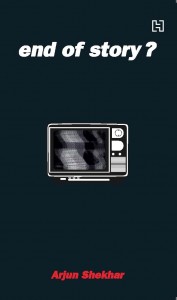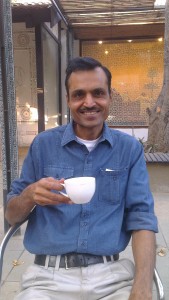How did you get the idea for End of Story?
I could make up an interesting story (as in part truth) but let me be honest instead. My daughter, who is the muse for one of the characters, has this innate curiosity which I am so envious of. She has a million questions tucked away in the attic of her mind, another thousand questions up her sleeve, and a hundred on her lips. At one time we had to censor her in front of our friends because she was embarrassing us in public all the time.
She made me realise how few questions we asked as adults; we seem to be embarrassed to let on that we don’t know something. On the other hand, we are being told billions of stories today – ad folks, media, lawyers and ordinary people are pulling out all the stops to convince us to influence us. We always were Homo-narrans – the story telling species – but suddenly there is an explosion of words. In this Age of Expression, we have all become word merchants and the internet, the Tower of Babble, is our market place where we come to trade and swap stories every day. Now, this is a dangerous scenario, because we need to be sure of the stories we are buying. We need to have better narrative literacy; we need to be probing, punching, and struggling with the stories before internalizing them.
Hence End of Story? is an attempt to wake up the reader to the need to ask questions which are a natural antidote to the indigestion or rash that a wrongly ingested story might give us. Questions are the Crap-O-Meter that allow us to unearth how much truth and how much bull shit is there in any story.
To get this idea across, I purposely decided to use a kind of mental judo, viz. use a gripping story to expose the stricture of the story in this thriller like novel.
For a plot that involves media manipulation, corruption and business interests, there must have been plenty of research that you needed to do. How did you go about researching?
Having one foot in the corporate sector helped. The research on advertising and media involved primary research by watching a lot of ads and tabloid channels. I also read a book called Hidden Persuaders by Vance Packard about the depth approach in advertising where he explains how in the ‘50s in the USA, where today’s advertising was born, cutting edge psychologists and sociologists were hired to get to the depth of why people buy what they do.
Finally, I have been following the paid news phenomenon ever since 2009 when it came out.
It seems a little far-fetched that electronic advertising would be banned by the Supreme Court. How did you decide to use that as the springboard for the book?
According to me electronic advertising is not harmless. It is at the core of the consumerist instincts that are devouring this planet. The idea of subliminal advertising is not new as I said earlier. Psychologists and sociologists have been employed by the advertising industry to find the deeper triggers and make us buy things almost unconsciously. Take the Cadbury’s Kuch Meetha Ho Jai line. Any time anything difficult is accomplished or a child wins something, the first thing they think of is to feed their sweet addiction. This subliminal line wires entire society into getting chocolates for gifts and prizes.
In the book, I stretch the idea further and have one of the characters create propogandads via a neuro-auditory technology that gets people to act socially responsible without knowing it. From here, we don’t have to take it much further to arrive at the possibility of terrorists to wire our minds for anti-social causes. Or politicians who use them for getting people to vote for them.
Do you think this would be harmless? And don’t you think the Supreme Court would hear a public petition that claims propogandads are being used to make people do things at the sub conscious or unconscious level.
Did you have a particular writing process for this book?
Writing to me is both a reflective process to clear my own head and a form of communicating those messages to the world but the key is to do it indirectly, in the sub text, rather than in your face. I believe people don’t like others talking at them.
If there is one style that I owe my writing to, I would call it the Vidushak or the Trickster. Like Birbal, Tenali Raman, Naseeruddin Hoja and several others, I like to allow the reader to participate in my plots and find out for themselves rather than dish out the answers upfront. To put it very directly: I am indirect in my messaging. Though the book is a thriller, you would appreciate that it’s not for the lazy reader; you have to work with me and all I can assure you is that you are going to be hit by something solid and insightful but you have to agree/commit to make the somewhat arduous journey with me.
The lead character, Shukrat Ali – is he inspired by a real person?
The protagonist, who is narrating the story in first person, Shukrat, has been carefully developed as a kind of a wimpy character who is totally opposed to his namesake Socrates. Despite being a TV anchor, he asks only comfortable questions, is not at all brave, believes in fate and destiny. The only thing he has in common with Socrates are his plain looks bordering on the ugly. But at times there are out-of-character hints of stress and violence which give us a peek behind the mask.
You might call him a mix of many anchors I have seen on tabloid TV channels. His personal characteristic resemble a friend who comes out as dithering but is very solid inside. In my character building I try to follow the adage: You can’t judge a book by its cover.
How much of yourself and your life experiences have seeped into the novel?
I guess all I can say is that I bring myself fully into everything I do. And in doing so, I naturally bring my own character into the way my novels are written. I always believe the author is a meta character and through the characters and their meanderings, the author is actually revealing his own hidden secrets of the mind to himself and to the readers.
Other things I bring to my novel is my own penchant for having my tongue mostly in my cheek, which turns sharp and vicious once in a while, and, of course, that hurts my cheek more than anybody else. But that style imbues the characters and descriptions, reflecting who I am – the invisible meta character in the novel.
And of course my experience of straddling both the corporate and NGO sector for nearly twenty- five years now allows me to play the outsider looking into both sectors. This lens has given me the ideas and plot for the story.
Are you working on your next book already? Can you tell us something about it?
I have almost finished the second of what I am calling The Homo-Narrans or Story Telling Species trilogy that is set in a trek to the Nanda Devi Base Camp. It’s an account of a fascinating quest of two researchers – a blind Norwegian woman and a Kumaonese prince – with their Bhotia guide, who are trying to search for a mystery village where people are said to have found the secret of happiness. They are following in the footsteps of a Norwegian anthropologist explorer in the late ‘50s had made a chance discovery of the village but had never been able to find it again. He had reported it in an obscure text that falls in the hands of the blind Norwegian woman during her stint as a researcher in an institute in Bergen, Norway. No one has ever found the village again or indeed has any knowledge of this tribe of perennially happy people.
The book is tentatively titled One for Sorrow, Two for Joy and looks at the question, What’s not in the plot of the happiness story/quest that all of mankind is on today or has been on for a long time. The book is told in the voices of the three trekkers who themselves go missing, but their diaries are found.
Publisher: Hachette
Price: Rs 350
Pages: 336
































